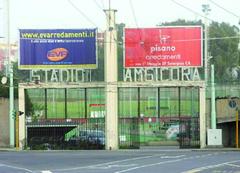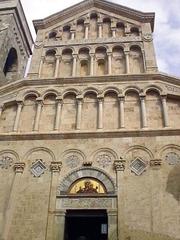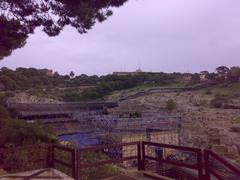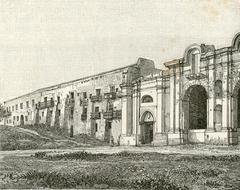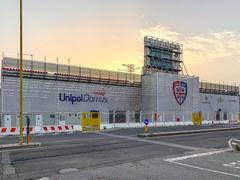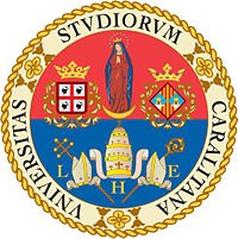Porta dei Leoni: Visiting Hours, Tickets, and Historical Sites in Cagliari
Date: 14/06/2025
Introduction
Porta dei Leoni, known as the “Gate of the Lions,” is a defining symbol of Cagliari, Sardinia. Rich in history and architectural splendor, this monumental gateway marks the entrance to the medieval Castello district—Cagliari’s oldest and most culturally significant neighborhood. Erected by the Pisans in the 13th century as part of an elaborate defensive system, Porta dei Leoni has stood witness to centuries of military conflict, urban change, and evolving civic identity (sardegna.italiaguida.it; contusu.it).
The gate’s enduring appeal is enhanced by its 19th-century neoclassical enhancements, including its iconic marble lion statues, symbolizing strength and vigilance (Sardegna Turismo; Visit Cagliari). Today, Porta dei Leoni is an open monument accessible around the clock, providing both a gateway to the Castello district and a unique opportunity for visitors to experience Cagliari’s rich historical tapestry (ArrivalGuides; Cagliari Turismo).
This guide details everything you need to know for your visit: historical context, architectural highlights, practical visitor information, transportation, accessibility, nearby attractions, and travel tips to help you fully experience this captivating site.
Table of Contents
- Historical Significance and Medieval Origins
- Architectural Features and Symbolism
- Integration with Castello and Urban Development
- Visiting Hours, Tickets, and Accessibility
- Getting There: Transportation Options
- Safety and Practical Travel Tips
- Guided Tours and Events
- Nearby Attractions
- Frequently Asked Questions (FAQ)
- Conclusion and Visitor Resources
Historical Significance and Medieval Origins
Porta dei Leoni’s origins trace back to the 13th century when the Pisans fortified the Castello district following their conquest of Cagliari in 1217. The gate was a critical piece in the city’s defenses, controlling access between the lower city and the administrative heart of Cagliari. Strategically located, it was flanked by towers and bastions—particularly the Torre dell’Aquila and Bastioni della Leona—underscoring its importance within a robust medieval network (sardegna.italiaguida.it; contusu.it).
Throughout the centuries, Porta dei Leoni endured sieges and bombardments, including significant damage during the 18th-century Spanish attacks and the French assault of 1793. Despite such trials, portions of the original medieval structure remain, offering a tangible link to Cagliari’s turbulent past.
Architectural Features and Symbolism
Originally built of local limestone and granite, Porta dei Leoni’s robust military design is accented by its later neoclassical additions. The 19th-century marble lions, now emblematic of Cagliari, were installed to evoke themes of vigilance and strength (Sardegna Turismo; Visit Cagliari). These statues, thought to have origins in earlier Roman or medieval structures, highlight the city’s tradition of repurposing its heritage.
The gateway’s elegant arches, decorative cornices, and the symbolic presence of the lions reflect a blend of martial and civic pride. This fusion of medieval fortification and neoclassical artistry makes Porta dei Leoni architecturally unique and symbolically rich.
Integration with Castello and Urban Development
Porta dei Leoni is integrally connected to Cagliari’s Castello district, the city’s historic core perched high above sea level. The district’s narrow lanes, noble palaces, and sweeping views encapsulate its medieval origins and continued role as a center of power and culture (sardegna.italiaguida.it; toonsarah-travels.blog).
In the late 19th and early 20th centuries, urban renewal projects led by Mayor Ottone Bacaredda transformed the area. Portions of the medieval walls were cleared to create grander, more accessible entrances, culminating in the construction of the nearby Bastion of Saint Remy and Terrazza Umberto I—essential stops on any visitor’s itinerary (meandsardinia.it).
Visiting Hours, Tickets, and Accessibility
- Visiting Hours: Porta dei Leoni is an open-air monument accessible 24/7. There are no official opening or closing times, and the gate is beautifully illuminated at night for evening visits (ArrivalGuides).
- Tickets: There is no entrance fee for Porta dei Leoni. Visiting is entirely free. Tickets may be required for nearby museums or attractions within the Castello district.
- Accessibility: The main approach is wheelchair-friendly, though surrounding cobblestone streets and moderate inclines may pose challenges. Assistance may be necessary for those with mobility concerns. Informative signage is available in Italian and English (Cagliari Turismo).
Getting There: Transportation Options
- By Air: Cagliari Elmas Airport is just 8 km from the city center, with taxis, rental cars, and train connections available.
- By Sea: The port, a major cruise and ferry terminal, is within walking distance of the historic center.
- By Rail: The main train station links Cagliari to other parts of Sardinia and is near the city center.
- Public Transport: CTM buses and trolleybuses serve central districts. The electric Line 7 connects directly to the Castello district, with a stop close to Porta dei Leoni.
- Walking: The gate is easily accessed on foot from Piazza Yenne or Marina district, involving a scenic 10–15 minute uphill walk.
- Parking: Limited due to the old town’s restricted traffic zones. Paid lots are available in adjacent neighborhoods.
Safety and Practical Travel Tips
- General Safety: Cagliari is safe for tourists. Exercise standard precautions against pickpocketing.
- Seasonal Considerations: Summers can be hot; bring water and sun protection. Comfortable footwear is recommended due to cobblestones and slopes.
- COVID-19: Restrictions have mostly been lifted, but check local guidance and carry masks if needed.
- Language: Italian is official, but English is commonly spoken in tourist areas.
- Currency: Euro (€). Credit cards are widely accepted, but carrying some cash is advised.
- Wi-Fi: Free public Wi-Fi is available near the gate and in many cafes.
Guided Tours and Events
Guided walking tours are widely available, offering deep historical and architectural context on Porta dei Leoni and nearby landmarks. These tours, often lasting 1–2 hours, can be booked in multiple languages and are especially recommended during peak tourism seasons (Cagliari Walking Tours).
The Castello district regularly hosts festivals, cultural events, and art exhibitions. Highlights include the Feast of Sant’Efisio and seasonal historical reenactments, adding a vibrant contemporary dimension to your visit (Sant’Efisio Festival; Cagliari Events).
Nearby Attractions
- Bastione di Saint Remy: Offers panoramic city views and easy access to the Castello district.
- Cagliari Cathedral: A stunning religious site with rich art and architecture.
- Torre dell’Elefante: A medieval tower with sweeping vistas over Cagliari.
- Museo del Castello: Documents the city’s layered history.
- Roman Amphitheater: A short distance away, this ancient site provides further historical context.
All are within easy walking distance of Porta dei Leoni.
Photographic Tips
The gate’s imposing architecture is best captured during early morning or late afternoon. The Terrazza Umberto I, above the Porta, is ideal for panoramic photographs of Cagliari and the Gulf. Night visits reveal the beautifully lit arch and lions—perfect for atmospheric shots.
Frequently Asked Questions (FAQ)
Q: What are Porta dei Leoni’s visiting hours?
A: Accessible 24/7 as an open-air monument.
Q: Is there a ticket fee?
A: No, entry is free.
Q: How can I reach Porta dei Leoni?
A: On foot from the city center, by bus (Line 7), taxi, or from the port/train station. Parking is limited near Castello.
Q: Is it wheelchair accessible?
A: The approach is accessible, but cobblestone streets may require assistance.
Q: Are guided tours available?
A: Yes, several walking tours include Porta dei Leoni and other historical landmarks.
Q: When is the best time to visit?
A: Early morning or evening during spring and autumn for fewer crowds and optimal lighting.
Conclusion and Visitor Resources
Porta dei Leoni is a testament to Cagliari’s enduring spirit, blending medieval fortification with neoclassical elegance and serving as a vibrant hub for both locals and travelers. Free, accessible, and rich in heritage, it invites every visitor to step through its arches and into Sardinia’s living history.
For an enriched experience, pair your visit with a guided tour, explore nearby attractions, and participate in local events. Use the Audiala app for up-to-date guides, maps, and exclusive content, and follow official tourism channels for the latest news about Cagliari’s historical sites.
References
- sardegna.italiaguida.it
- contusu.it
- Sardegna Turismo
- Visit Cagliari
- ArrivalGuides
- Cagliari Turismo
- meandsardinia.it
- toonsarah-travels.blog
- Cagliari Walking Tours
- Sant’Efisio Festival
- Cagliari Events
